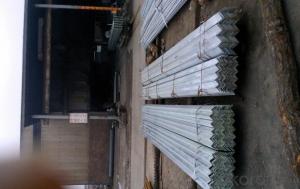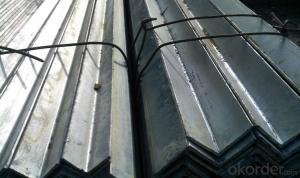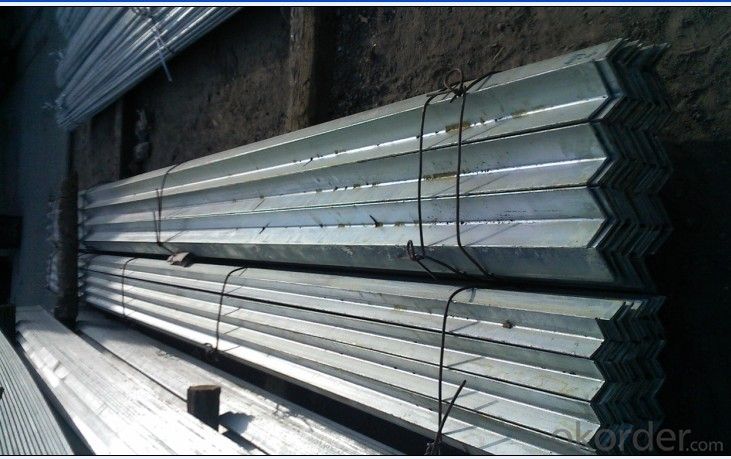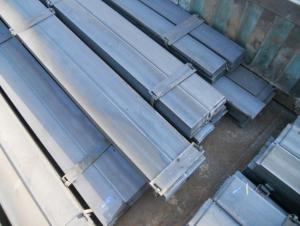high quality hot rolled low carbon steel angle bar
- Loading Port:
- Tianjin
- Payment Terms:
- TT OR LC
- Min Order Qty:
- 5 m.t.
- Supply Capability:
- 2000 m.t./month
OKorder Service Pledge
OKorder Financial Service
You Might Also Like
Product Description:
Specifications of Angle Steel
1. Invoicing on theoretical weight or actual weight as customer request
2. Length: 6m, 9m, 12m as following table
3. Sizes

Sizes: 25mm-250mm | ||
a*t | ||
25*2.5-4.0 | 70*6.0-9.0 | 130*9.0-15 |
30*2.5-6.6 | 75*6.0-9.0 | 140*10-14 |
36*3.0-5.0 | 80*5.0-10 | 150*10-20 |
38*2.3-6.0 | 90*7.0-10 | 160*10-16 |
40*3.0-5.0 | 100*6.0-12 | 175*12-15 |
45*4.0-6.0 | 110*8.0-10 | 180*12-18 |
50*4.0-6.0 | 120*6.0-15 | 200*14-25 |
60*4.0-8.0 | 125*8.0-14 | 250*25 |
5. Payment terms:
1).100% irrevocable L/C at sight.
2).30% T/T prepaid and the balance against the copy of B/L.
3).30% T/T prepaid and the balance against L/C
6.Material details:
Alloy No | Grade | Element (%) | |||||
C | Mn | S | P | Si | |||
|
|
|
|
|
|
| |
Q235 | B | 0.12—0.20 | 0.3—0.7 | ≤0.045 | ≤0.045 | ≤0.3 | |
|
|
|
|
|
|
| |
Alloy No | Grade | Yielding strength point( Mpa) | |||||
Thickness (mm) | |||||||
≤16 | >16--40 | >40--60 | >60--100 | ||||
≥ | |||||||
|
|
|
|
|
| ||
Q235 | B | 235 | 225 | 215 | 205 | ||
Alloy No | Grade | Tensile strength (Mpa) | Elongation after fracture (%) | ||||
Thickness (mm) | |||||||
| ≤16 | >16--40 | >40--60 | >60--100 | |||
≥ | |||||||
|
|
|
|
|
|
| |
Q235 | B | 375--500 | 26 | 25 | 24 | 23 | |
Usage & Applications of Angle Steel
According to the needs of different structures, Angle can compose to different force support component, and also can be the connections between components. It is widely used in various building structures and engineering structures such as roof beams, bridges, transmission towers, hoisting machinery and transport machinery, ships, industrial furnaces, reaction tower, container frame and warehouse etc.
Packaging & Delivery of Angle Steel
1. Packing: it is nude packed in bundles by steel wire rod
2. Bundle weight: not more than 3.5MT for bulk vessel; less than 3 MT for container load
3. Marks:
Color marking: There will be color marking on both end of the bundle for the cargo delivered by bulk vessel. That makes it easily to distinguish at the destination port.
Tag mark: there will be tag mark tied up on the bundles. The information usually including supplier logo and name, product name, made in China, shipping marks and other information request by the customer.
If loading by container the marking is not needed, but we will prepare it as customer request.
Production flow of Angle Steel
Material prepare (billet) —heat up—rough rolling—precision rolling—cooling—packing—storage and transportation
- Q: Are steel flat bars used in the construction of bridges or infrastructure?
- Yes, steel flat bars are commonly used in the construction of bridges and infrastructure. Steel flat bars are versatile and strong, making them suitable for various applications in construction projects. They are often used as structural components in bridge construction, providing support and stability. Steel flat bars can also be used in the construction of infrastructures such as buildings, roads, and railways, where their strength and durability are valued. Additionally, steel flat bars can be easily fabricated and welded, making them a preferred choice in construction projects that require customization and flexibility. Overall, steel flat bars are widely utilized in the construction industry for their reliability, strength, and versatility.
- Q: Can steel flat bars be used for making molds or dies?
- Yes, steel flat bars can be used for making molds or dies. Steel is a versatile material known for its strength and durability, making it suitable for various applications in industries such as manufacturing and engineering. When used for making molds or dies, steel flat bars offer the necessary stability and rigidity to withstand the pressures and forces involved in the molding or die-cutting process. Moreover, the flat surface of the bars ensures precise and accurate shaping, allowing for the production of high-quality molds or dies. Steel flat bars can be machined, welded, and heat-treated to achieve the desired specifications and characteristics required for specific molding or die-cutting applications.
- Q: What are the different methods of surface engraving for steel flat bars?
- There are several methods of surface engraving for steel flat bars, including laser engraving, etching, stamping, and chemical etching.
- Q: Can steel flat bars be used for creating frames or supports in artwork?
- Yes, steel flat bars can definitely be used for creating frames or supports in artwork. Steel is a strong and durable material that can provide stability and structural integrity to art pieces. Its strength allows it to bear the weight of larger artworks or provide a sturdy base for sculptures. Steel flat bars can be easily cut, welded, and shaped to fit the desired dimensions and design of the frame or support. Additionally, steel is resistant to corrosion, which ensures the longevity of the artwork. This versatility and reliability make steel flat bars an excellent choice for creating frames or supports in various types of artwork.
- Q: What is the difference between a steel flat bar and a steel hex bar?
- The main difference between a steel flat bar and a steel hex bar lies in their shape and design. A steel flat bar, as the name suggests, is a long, rectangular-shaped bar with a flat surface on all sides. It has a uniform thickness throughout its length and is typically used for structural applications, such as supports, braces, and framing. The flat surface allows for easy fastening or welding to other components. On the other hand, a steel hex bar is a bar with six equal sides, forming a hexagonal shape. This unique design provides increased strength and stability compared to a flat bar. The hexagonal shape also offers better grip and torque resistance, making it suitable for applications that require high tensile strength, such as machinery, tools, and hardware components. In terms of versatility, a steel flat bar can be easily manipulated, cut, or bent to fit various shapes and sizes, making it a more flexible option for different projects. Conversely, a steel hex bar is more rigid and less malleable due to its six-sided structure, limiting its adaptability but enhancing its strength. In summary, while both steel flat bars and steel hex bars are made from the same material, their distinct shapes and designs make them suitable for different applications. The flat bar is commonly used for structural purposes, while the hex bar is preferred for applications requiring higher strength and torque resistance.
- Q: Can steel flat bars be bent or shaped?
- Yes, steel flat bars can be bent or shaped to a certain extent using specialized tools and techniques such as a hydraulic press or a bending machine.
- Q: Are steel flat bars suitable for load-bearing shelves or platforms?
- Yes, steel flat bars are suitable for load-bearing shelves or platforms. Steel is known for its strength and durability, making it a reliable choice for supporting heavy loads. The flat shape of the bars provides stability and even weight distribution, making them ideal for load-bearing applications.
- Q: Are steel flat bars easy to work with?
- Yes, steel flat bars are generally considered to be easy to work with. They are versatile and can be easily cut, drilled, welded, and shaped to fit various applications. Steel flat bars have a uniform shape and are available in a range of thicknesses, widths, and lengths, making them suitable for a wide range of projects. Additionally, they have good strength and durability, making them a popular choice in construction, manufacturing, and DIY projects. However, it is important to note that working with steel flat bars may require certain tools and skills, and precautions should be taken to ensure safety.
- Q: What are the common load-bearing capacities of steel flat bars?
- The common load-bearing capacities of steel flat bars vary depending on their dimensions and specific grade of steel. However, typical load-bearing capacities range from a few hundred pounds to several thousand pounds. It is advisable to consult engineering manuals or professionals for precise load-bearing capacity information based on the specific flat bar dimensions and steel grade.
- Q: Can steel flat bars be used in the marine industry?
- Steel flat bars are indeed suitable for use in the marine industry. This material, known for its durability and resistance to corrosion, is commonly utilized for a variety of marine applications. When constructing ship hulls, decks, and other structural components, steel flat bars are often chosen due to their strength and stability. They are also frequently employed in the fabrication of marine equipment and machinery. Another advantage of steel flat bars is their ability to withstand the harsh marine environment, including exposure to saltwater, waves, and extreme temperatures. Nonetheless, it is crucial to utilize high-quality, marine-grade steel that is specifically designed to resist corrosion and maintain its structural integrity in saltwater environments. In order to ensure the longevity and performance of steel flat bars in the marine industry, regular inspection, maintenance, and proper coating or painting are essential.
Send your message to us
high quality hot rolled low carbon steel angle bar
- Loading Port:
- Tianjin
- Payment Terms:
- TT OR LC
- Min Order Qty:
- 5 m.t.
- Supply Capability:
- 2000 m.t./month
OKorder Service Pledge
OKorder Financial Service
Similar products
Hot products
Hot Searches
Related keywords
































